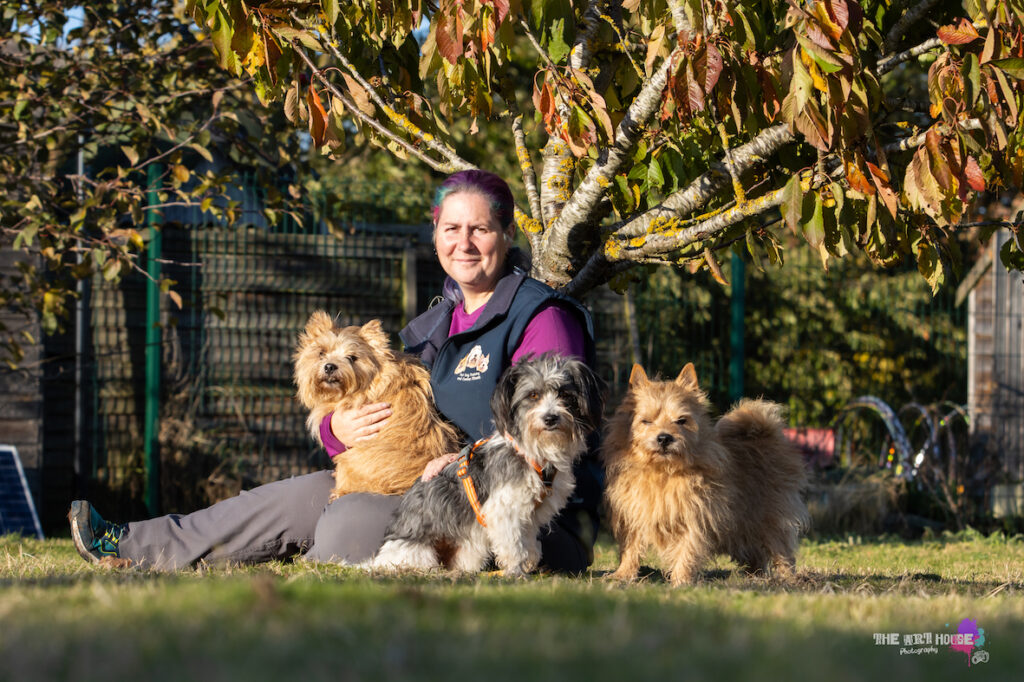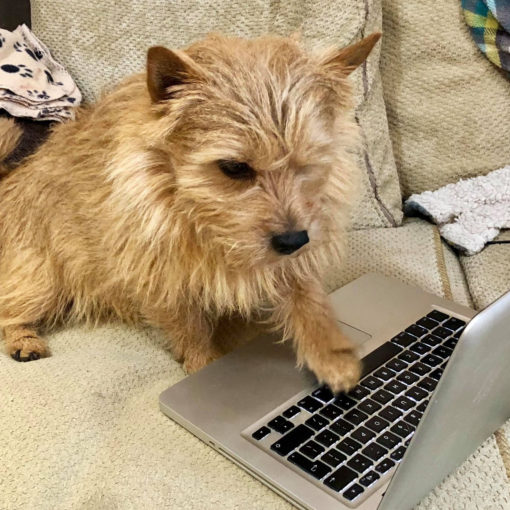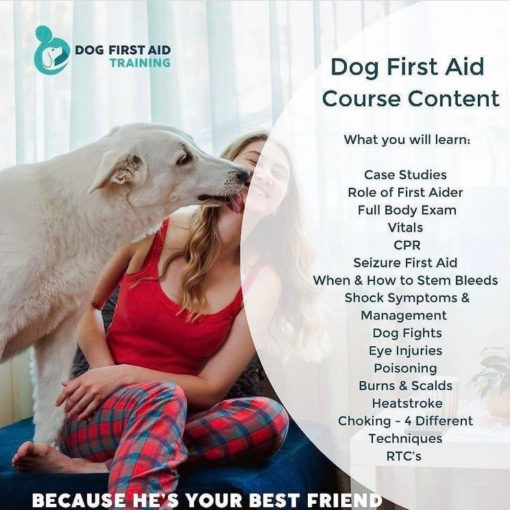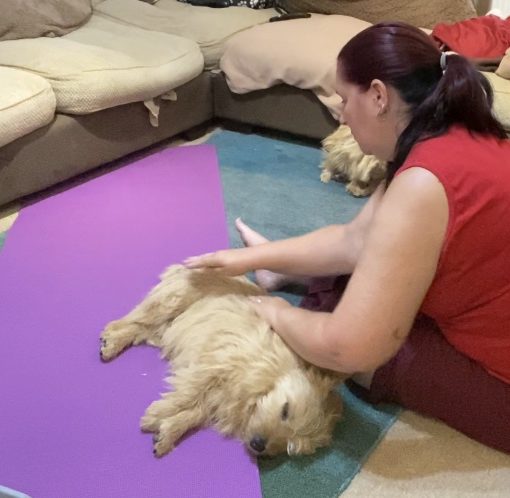While some dogs can have a natural approach to being clumsy and are mostly paws, tail and ears, sometimes our dogs and puppies need more from us to help with not causing damage and destruction wherever they go!
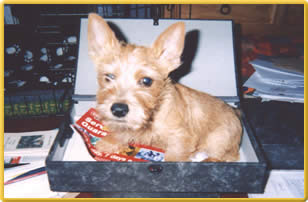
I was recently asked to provide some expert tips on dogs causing chaos in the home such as digging the soil from potted plants or knocking lamps over with their tail and it gave me a chance to think about this more.
I hope this blog is interesting and even helpful!
- Prevent Accidental Damage and Destruction – if you’ve had a dog with a long and powerful tail you’ll know how often that tail knocks items off of coffee tables, chairs, windowsills etc! Sometimes we need to acknowledge that our home is not designed for a happy waggy tail and move ornaments, photo frames, vase of flowers etc to another location where they aren’t going to be swept to the floor by a tail.
Moving items that are on lower surfaces and can be reached by tails as a dog turns or wags is a quick fix and can prevent items getting damaged and in turn prevent your dog being injured. Higher shelves, display units with glass doors and using storage boxes all help with this!
Sometimes dogs are just clumsy and can walk into things, knock items while they are playing or fling a toy about and damage something on display. All accidental of course but can be costly to replace or fix!
Although it’s nice to display items, photos etc when we share our home with dogs we need to decide what is more important; ornaments or our dog’s enjoyment! Maybe have items higher up, in another room or secure them in a way that dog tails, paws and heads cannot reach.
Some dogs with long, full tails that are strong and belong to taller dogs can hit tables, door frames, walls etc so hard it damages the tail including splitting it. This can then be incredibly difficult to heal as dogs wag their tails and the bandage flies off, they hit it on something else and open up the wound again, often amputating the end of the tail in the most comfortable option! So it can be worth moving furniture around to help your dog avoid additional surgery!
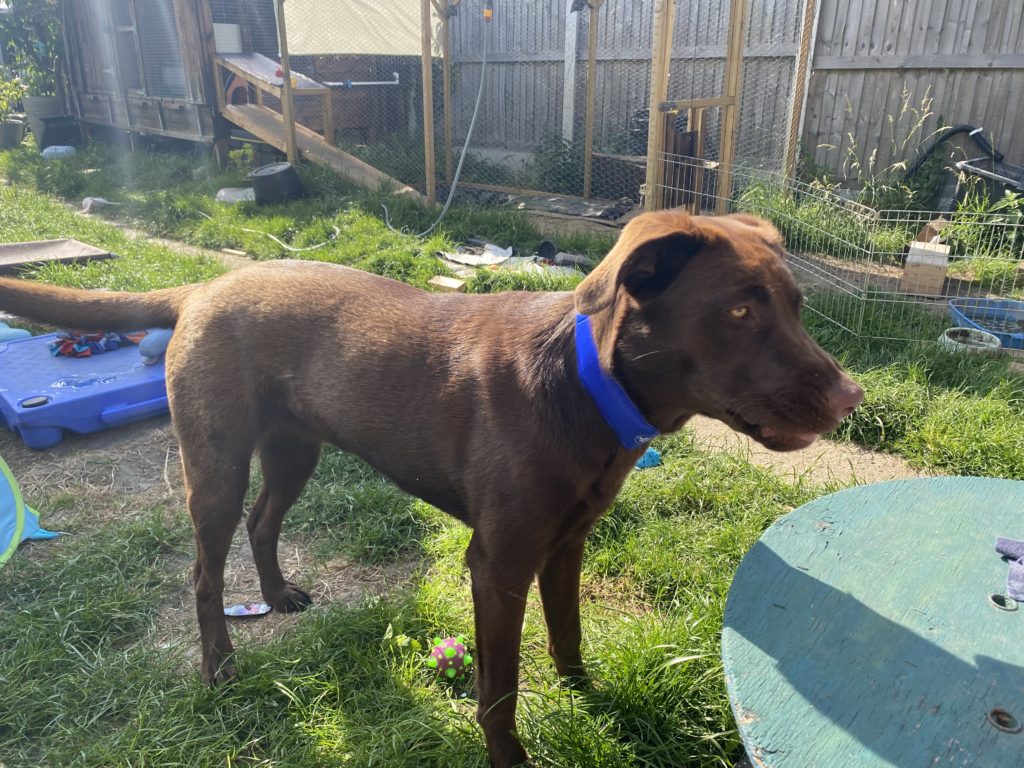
- Understand Destructive Behaviours
By destructive behaviours we mean activities dogs do to intentionally break or damage something. There can be various reasons why dogs will chew, dig, shred etc.
- Digging or chewing etc can result from boredom such as when it’s raining hard and a dog doesn’t have the option to mooch outside or while owners are busy working or with visitors. They can be behaviours that entertain dogs but also can be to gain attention when their owners are occupied! Afterall, even attention such as being told off is still attention!
- In some cases separation issues when left alone can lead to dogs displaying destructive behaviours. These can be as a way to help lower their stress levels such as chewing to release endorphins or breaking an item to make a noise as it usually calls their owners back. When separation issues are the cause of chewing etc you’ll often find a dog doesn’t do the behaviour while they are with their family and have access to them but can start any time once they are separate; either in another part of the house such as when their owner goes to take a shower and shuts the door or when owners are out of the house completely.
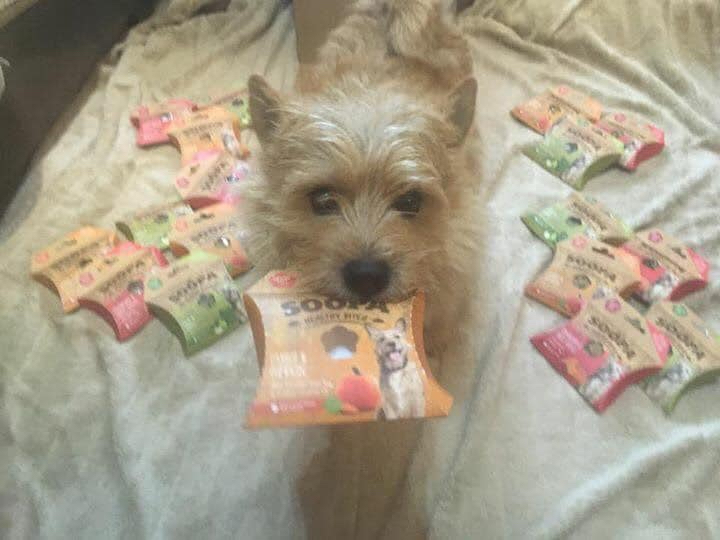
If Separation Issues are suspected it would be advisable to work with a dog behaviourist or specialist in Separation Anxiety to help your dog feel calm when on their own which would in turn take away the behaviours. Also it’s important to know that dogs are not ‘getting revenge’ for their family going out by shredding the doormat etc!
When finding a suitable Trainer or Behaviourist a good way is to ask people you know if they have used a certified professional and what help was needed so you can find recommendations for your needs or if looking online check reviews and testimonials to ensure the person you are considering has got good feedback for Separation Issues with dogs.
- Provide Positive Outlets
When a dog is looking for a way to stimulate their brain or an outlet for their energy there are many ways we can help them which then helps dogs not disrupt the house!
Finding activities that suit each dog’s personality, ways of playing and natural breed instincts can be key to preserving the inside of your home and your garden too. Here are some examples:
Play is a great way to interact with and bond with your dog. It doesn’t need to take up a lot of space and most dogs will play in some way, even if they aren’t interested in toys! My own dogs aren’t high toy driven terriers but they play by finding treats hidden inside treat toys, doing fun tricks like spins and roll over as well as chasing me if I move away and call them. It’s all play, just adapted around them.
If your dog does play with toys then moving the toy around for them to chase is a great game, hiding it behind you and encouraging them to find it is another game and of course good old tuggie.
Did you know Tuggie doesn’t teach dogs to be dominant, but can raise a dog’s confidence levels. Great for a shy dog, but an over confident dog that already pushes boundaries may not need a confidence boost. In these cases Tuggie can still be played but at the end of the game put the toy away rather than leaving it out for your dog (they can have other toys)
- Use activity toys to deliver part of meals or treats (give part meal as normal and then some in a toy). There are a huge amount now such as Nina Ottosson, Trixie, Kong and more. Food is put inside in little compartments and dogs are encouraged to slide, push, pull or move lids to reveal the hidden treats or food. These are useful for dogs who like to use their brain and learn things, great for dogs who are new to you as a bonding game and for dogs who have had surgery or been unwell and need to physically take it easy but their minds are wanting to be active. There are also snuffle mats, activity mats and more. If your dog can be tense around food be careful with feeding only in toys as they can cause a level of frustration, so easy toys or hiding a few smaller bowls with parts of a meal may be better.
- Please be aware that interactive toys etc are not intended to be left down for dogs to access all the time and are not chew proof so picking up after use and before you go out is advised.
- Teach fun and practical tricks, such as fetching your slippers to bring to you, closing internal doors, or finding the TV remote. Fun tricks can be adjusted to each dogs needs and abilities and can include jumping over your arm, roll over, leg weaves and more but can also be less active such as chin target, give paw and play bow.
- To teach tricks there are many in person training opportunities such as Tricks workshops and individual training plus online is very popular for Tricks training.
Our own Online Monthly Tricks Club offers tutorials on tricks from starters to advanced with Tricks progressions and alternative methods as there’s never one size fits all with dog training. There’s over 40 tricks already plus feedback and advice on any tricks you’re working on.
Why not try the Tricks Club for 7 Days for Free and see what you think!
https://www.patreon.com/c/joenutkinscassntay/membership?view_as=patron
Our new paperback Tricks book gives details on each trick for larger and smaller dogs with adjustments to help the training go smoother no matter what size your dog is. It’s on Amazon and has a wide range of levels of tricks.
Take a look at the Book here:
There are so many types of training activities for dogs that dogs of all backgrounds are catered for from active like Hoopers and Agility to more subtle like Scentwork and Memory Skills. See what is near you and ask for information or to watch a session to see if you’d like to take part.
- Manage Play Styles
- Excitable, high energy play indoors can lead to more hyperactive behaviour as dogs can get into a routine of play that involves running, jumping etc and this leads to play being more exciting and in turn rooms take a beating! Look at how different people in the home interact with your dog. Play in the home can still be interesting but calmer, in one area to promote a calmer style.
- Reserve energetic activities for outdoors in the garden, on walks, in enclosed fields or if you have a room in the house with less furniture or items this could potentially be a good place for more excitable play but restrict it to here not slipping into other parts of the house where you want calmer interaction. Energetic play would be activities like chasing you or playing fetch, pushing a football about or on the floor with your dog for a good wrestle!
- Excitable, high energy play indoors can lead to more hyperactive behaviour as dogs can get into a routine of play that involves running, jumping etc and this leads to play being more exciting and in turn rooms take a beating! Look at how different people in the home interact with your dog. Play in the home can still be interesting but calmer, in one area to promote a calmer style.
- Encourage calmer play in places where you want your dog to be calmer overall with family, visitors, household items etc, Calmer will interactions can include touch-based play like belly rubs and massage, hiding toys or treats for your dog to find.
- Teach ‘Settle’ to help your dog switch off
- A settle can help dogs relax in shared living spaces such as when there are various family members in one home which can be exciting when people are coming and going.
- Settle can be useful when rooms are opened up for family time that might usually have the door closed and so this becomes exciting for a dog as they have access and a different room, more people, and if it’s a room with more valuable furniture etc there might be excitement when owners are trying to catch the dog before they jump on the table! If they get into a pattern of settling on a mat or bed whenever they are in this room it can become more automatic and less exciting.
- Another benefit of teaching Settle is when owners are at home but are working or spending time with visitors. Once a settle is taught it can be used with all kinds of distractions and without us needing to be next to our dog to remind them what to do. A settle can help dogs not get excited and jump on visitors which could lead to damaging clothing, falling on items and breaking them.
- A settle can help dogs relax in shared living spaces such as when there are various family members in one home which can be exciting when people are coming and going.
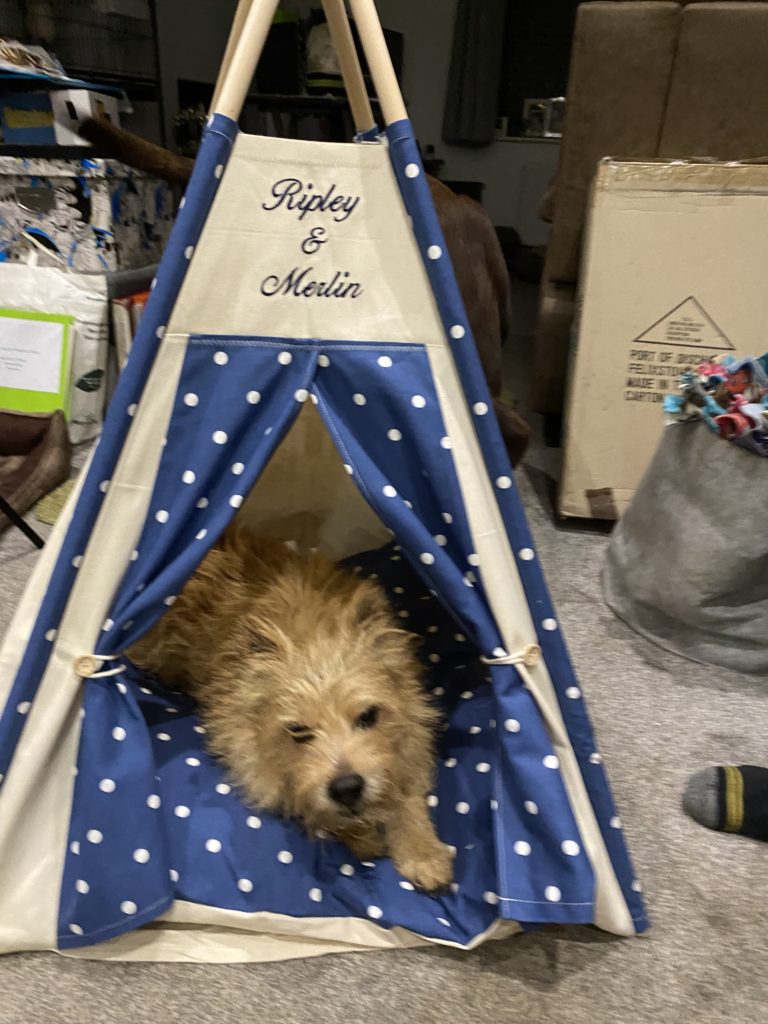
- Management / Prevention:
There’s also management as a way to help dogs not accidentally cause chaos – By ensuring you don’t leave items in your dog’s reach when you aren’t there or aren’t able to watch them you dog doesn’t get the chance to practise damaging things. Especially puppies or dogs new to your home who may be investigating! - Using cupboards, boxes with lids, pushing items to the back of counter tops etc can help dogs not reach items they might try to take and keeping plants or favourite rugs in rooms they are not left in when you go out will help protect those too.
- Everything we touch we leave our scent on and the items we love the most may have more scent so our dogs will be attracted to these and it makes sense that they are more likely to try and be close to these items which can easily lead to them being damaged.
Take away the opportunity to cause damage by not having items in reach or closing rooms off.
Has your dog ever damaged, broken or destroyed something? What was it and what did they do?
We contributed to a story on Newsweek Online this week after a dog went viral online for making a mess in his home through digging the soil in a houseplant and other escapades! Take a look at the story and our advice here:
We hope this blog has been of use to you. For training and help with things like The Settle or help with general training with your Puppy or Dog get in touch with us:
Email: joe@dogtrainingessex-suffolk.co.uk
WhatsApp/ Text: 07809117912
https://www.instagram.com/cassntay?igsh=MXY1dm1vM3VoNjFyYg%3D%3D&utm_source=qrFind us on Instagram: @Cassntay
Find us on Facebook: Dog Training for Essex & Suffolk
